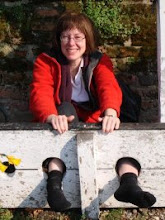The size is 81 x 96 inches, for a double bed and rectangular in size.
 The design is clearly a stamped design, and is very similar to that on the Blue Allendale and also the two examples shown in the Beamish book, Quilts and Coverlets. All clearly by the same hand, the little hand marked feathers are so distinctive. There is one mark on the quilt, which you can see in this photo but otherwise in very good condition. Date is about 1900-1910.
The design is clearly a stamped design, and is very similar to that on the Blue Allendale and also the two examples shown in the Beamish book, Quilts and Coverlets. All clearly by the same hand, the little hand marked feathers are so distinctive. There is one mark on the quilt, which you can see in this photo but otherwise in very good condition. Date is about 1900-1910.
The swag border is slightly different - not a fleur de lys but a circle with three feathers poking out as a corner device - also notice that the swags have trefoils not roses.

Central area very similar - except - can you see that surrounding the central rose, there is a circle of straight feathers or ferns. I find it difficult to tell the difference between these two patterns - Lilian says that in feathers the lines and ends are curved whereas in leaves the lines are straight and the ends pointed. The stitching in this quilt is very neat and well done. As was common, there are two lines of machine stitching around the edge of the quilt.
 Another look at the corner design. What I cannot understand is that there is no blue pencil to be seen on this quilt. Some of the older quilts have been intensively used and washed and yet traces of blue pencil still remain. However here, with the quilt is pristine condition, there is no trace to be seen. Was there a special way to wash the quilt to get rid of the markings? Were a variety of different pencils used? I don't know!!
Another look at the corner design. What I cannot understand is that there is no blue pencil to be seen on this quilt. Some of the older quilts have been intensively used and washed and yet traces of blue pencil still remain. However here, with the quilt is pristine condition, there is no trace to be seen. Was there a special way to wash the quilt to get rid of the markings? Were a variety of different pencils used? I don't know!!
Detail of the pierced ferns which are typical of Allendale quilts. You can also see the ring of straight feathers/ferns surrounding the central rose.

The 3/4 inch diamond infill is well marked and well stitched and looks very elegant. This quilt in white would have been a "best" quilt.

Corner of the quilt - corner rose plus the machine stitching on the knife edge to create a firm edge to the quilt. Post war, the Womens' Institute had exhibitions where any quilts with this treatment were disqualified - the WI only approved of hand stitched edges - and yet it was a widely used technique.
No provenance for this quilt. It came from a large collection of quilts where no information was recorded.

Another beautiful quilt. I really am enjoying your blog, it's interesting and informative and your photos are excellent.
ReplyDeleteThese quilting patterns are so beautiful! I think they should be used by today's quilters as well as they were used in former times. It is a heritage we can carry on.
ReplyDeleteI always look at your pictures again and again, Pippa! Thank you for sharing!